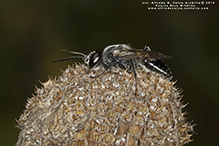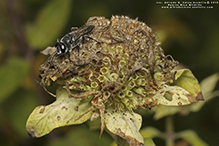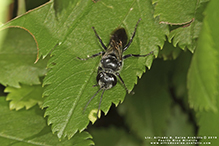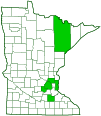crabonid wasp
(Astata unicolor)
Conservation • Description • Habitat • Biology • Distribution • Taxonomy
Conservation Status |
|
|||||||
| IUCN Red List | not listed |
|||||||
| NatureServe | not listed |
|||||||
| Minnesota | not listed |
|||||||
Description |
||
Astata unicolor is a solitary, ground nesting, predatory wasp. It occurs across southern Canada, throughout the United States and Mexico, and in Central America. It is the most common Astata species in eastern North America, but it is not common anywhere. It is the only Astata species recorded in Minnesota. Adults are found in July and August in fields and savannas. Adults are small, stout bodied, and hairy. Females are ⅜″ to ½″ (9 to 13 mm) in length. Males are a little larger, ⅜″ to 9⁄16″ (10 to 14 mm) in length. The body is shiny but coarsely pitted (punctate). On the female the head is entirely black and is thickly covered with short, erect, silvery-white hairs. The compound eyes are black and large. They do not meet at the top of the head. The top of the head is heavily pitted. The antennae have 12 segments, composed the scape and pedicel at the base and a whip-like third section (flagellum). The first flagellomere is the longest, the second is much shorter, and the remaining become progressively smaller. The thorax is entirely black and is thickly covered with short, erect, silvery-white hairs. The upper side is shiny. The exoskeletal plate covering the first segment of the thorax (pronotum) is short and collar-like. The abdomen has 6 segments and may be either entirely red or entirely black. Each segment has short, sparse hairs on the margins. On the underside of the abdomen there are sparse, bristle-like hairs on the front margin of each segment. The forewing is mostly light brown, darker toward the tip. The marginal cell is long, extending beyond the third submarginal cell, and it is cut off (truncate) at the end, not pointed. The marginal vein continues a short distance beyond the marginal cell. There are three submarginal cells. The first recurrent vein meets the second submarginal cell near the middle. On the hindwing the anal lobe is narrow. The rear lobe at the base (jugal lobe) is long, much more than half as long as the anal area. The legs are black, hairy, and spiny. The fourth segment on the middle leg has two spurs at the tip. The last part of the leg (tarsus), corresponding to the foot, has five segments. The last segment has a pair of claws at the tip. The claws are not split. The tibia and tarsus are spiny, especially on the middle and hind legs. On the male the compound eyes are reddish-brown and meet at the top of the head. The antennae have 13 segments. The fourth through eighth flagellomeres are enlarged and broadly convex below. The abdomen has 7 segments and is always entirely black. The first segment has long twisted hairs. The remaining segments have short hairs on the margins. The hairs on the underside of the abdomen are long and twisted. The wings are clear, sometimes light brown in the central area. On the hindwing the anal lobe is very broad. |
||
Size |
||
Female: ⅜″ to ½″ (9 to 13 mm) Male: ⅜″ to 9⁄16″ (10 to 14 mm) |
||
Similar Species |
||
Habitat |
||
Fields and savannas |
||
Biology |
||
Season |
||
July and August (CCESR) |
||
Behavior |
||
|
||
Life Cycle |
||
The female constructs a short-sided burrow, often with just a single cell, in loose soil. She provisions it with the larva of a stink bug. |
||
Larva Food |
||
Paralyzed larva of several species of stink bugs, including brown marmorated stink bug (Halyomorpha halys), dusky stink bug (Euschistus tristigmus luridus) and spined soldier bug (Podisus maculiventris). |
||
Adult Food |
||
Flower nectar |
||
Distribution |
||||
|
Sources |
|||
| 8/24/2022 | ||||
Occurrence |
||||
Widely distributed. Not common anywhere. |
||||
Taxonomy |
|||
Order |
Hymenoptera (ants, bees, wasps, and sawflies) | ||
Suborder |
Apocrita (narrow-waisted wasps, ants, and bees) | ||
Infraorder |
Aculeata (ants, bees, and stinging wasps) | ||
Superfamily |
Apoidea (bees and apoid wasps) | ||
Family |
Crabronidae (square-headed wasps, sand wasps, and allies) | ||
Subfamily |
Astatinae | ||
Genus |
Astata | ||
Synonyms |
|||
Astata insularis Astata rufiventris |
|||
Common Names |
|||
This species has no common name. One of the common names for the family Crabronidae is crabonid wasps, and it is adopted here for convenience. |
|||
Glossary
Flagellomere
A segment of the whip-like third section of an insect antenna (flagellum).
Jugal lobe
In Hymenoptera: The rear lobe at the base of the hindwing.
Pronotum
The exoskeletal plate on the upper side of the first segment of the thorax of an insect.
Punctate
Dotted with pits (punctures), translucent sunken glands, or colored spots of pigment.
Tarsus
On insects, the last two to five subdivisions of the leg, attached to the tibia; the foot. On spiders, the last segment of the leg. Plural: tarsi.
Tibia
The fourth segment of an insect leg, after the femur and before the tarsus (foot). The fifth segment of a spider leg or palp.
Visitor Photos |
|||||
Share your photo of this insect. |
|||||
| This button not working for you? Simply email us at info@MinnesotaSeasons.com. Attach one or more photos and, if you like, a caption. |
|||||
Alfredo Colon |
|||||
 |
 |
||||
 |
 |
||||
MinnesotaSeasons.com Photos |
|||||
|
|||||

Slideshows |
||

Visitor Videos |
|||
Share your video of this insect. |
|||
| This button not working for you? Simply email us at info@MinnesotaSeasons.com. Attach a video, a YouTube link, or a cloud storage link. |
|||
Other Videos |
|||
| Astata Unicolor Wasp Carrying Brown Marmorated Stinkbug Nymph Candle-Lit Scene |
|||
About
Feb 7, 2022 |
|||


Created: 8/25/2022
Last Updated:



